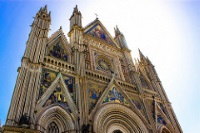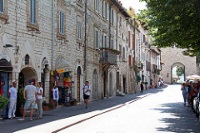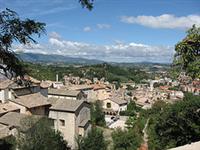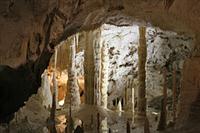Umbria Travel Guide
Umbria sits in the shadow of Tuscany, its better-known northern neighbour, but is fast becoming a favoured destination for those who want to discover rural Italy away from the crowds. The area is predominantly rural, with no major cities and a small population of under a million. Umbria is landlocked and situated in the heart of Italy, north of Rome, with the Marches region to the east, Latium to the south and Tuscany to the north. Umbria is only one to two hours' drive from either the Rome or Pisa airports, and can be accessed via the A1 toll road, which runs through the region from Rome to Florence.
The region is dotted with remarkably unspoilt medieval hill towns and villages, ancient castles and Roman ruins, and a rolling countryside of forests, olive groves and vineyards. The famous Tuscan towns of Florence, Siena and Pisa are all within driving distance, but Umbria also has many of its own magnificent sights. These include the cathedral facade in Orvieto, the Roman theatre in Spoleto and the town of Assisi, whose Basilica ranks among Italy's must-see sights along with Pompeii, St Mark's Square and the Colosseum.
Perugia is the region's main city and is the place to head for shopping, bars or any nightlife, but visitors are still more likely to visit Umbria to hike through the unspoilt countryside, slumber by the pool and enjoy the delicious local wine and food.
Things to do in Umbria
Birthplace of Saint Francis in the 12th century and home to the incredible Basilica di San Francesco, Assisi is one of Italy's most celebrated attractions and the main draw for visitors to Umbria. It's a place with a palpably holy atmosphere, with the countless art treasures in the Basilica alone enough to justify an Umbrian holiday. The medieval fortress town of Orvieto is another very popular destination in Umbria, as is the picturesque ancient town of Spoleto, which was established by the Romans in the 3rd century BC.
By contrast, the capital city of Perugia is not that well known among travellers despite being an ancient Etruscan settlement, and reputed in Italy as a centre for art and culture. Visitors to Perugia will find it a charming destination of coloured houses, vast greenery and spring breezes, as well as enchanting gothic architecture and Renaissance frescoes. The city of Terni, in southern Umbria, also has much to offer, as there are a number of archaeological sites to explore. Terni is best known to travellers for the magnificent Cascata delle Marmore, an artificial waterfall created by the Romans that remains one of the tallest man-made waterfalls in the world. The Umbrian city of Gubbio draws visitors with its incredible street art and delightful medieval town center, which has several scenic terraces that provide breathtaking views of the surrounding countryside.
Umbria is not as packed with tourists as some other regions of Italy, which allows visitors to sightsee in relative peace and enjoy the rustic, laid-back charms of the area without the crowds that can prove so frustrating in the big Italian cities. The best time to visit Umbria is in the shoulder seasons of spring and autumn (April to May and September to October).

Orvieto
The medieval fortress town of Orvieto is dramatically perched on a hilltop overlooking the Umbrian countryside. It's thought to have been an important centre for Etruscan civilisation and many impressive artefacts can be viewed in its archaeological museum. The town remains almost unchanged since medieval times, and even in summer is not too packed with tourists.
The 13th-century Duomo of Orvieto, with its magnificent facade and frescoes, dominates the skyline. Visitors should also take time to wander around the town's backstreets to find hidden gems and enjoy amazing views over the city walls and battlements. The best restaurants are tucked away in the side streets off the main square.

Assisi
The picturesque hill town of Assisi is famous as the birthplace of St Francis, a 12th-century monk who founded the Franciscan order, which is devoted to practices of asceticism, frugality and chastity. Tourists and pilgrims flock to the bustling town for inspiration and worship, and a multitude of annual conferences, festivals and other religious activities. Assisi is a visual spectacle of shimmering white marble buildings perched halfway up Mount Subasio. The town is set against the backdrop of the towering 14th-century hill fortress of the Rocca Maggiore, a landmark with which to orientate oneself from inside the city's medieval ramparts.
One of the most loved and visited churches in Italy is the 13th-century Basilica di San Francesco, which contains frescoes by Giotto commemorating the life of St Francis. Giotto is regarded as the father of European painting and the first of the great Italian masters.
Other notable works include paintings by Pietro Lorenzetti and Simone Martini's frescoes based on the life of St Martin. St Francis's tomb rests below the lower church, while other popular sights include the 13th-century Basilica di Santa Chiara, the 12th-century Romanesque Duomo di San Rufino and the Eremo delle Carceri, a monastery situated in the woodland outside Assisi.
Assisi is a beautiful city with winding streets, Roman ruins and magnificent churches, feeling like it has changed little since medieval times. The greatest gems are the small medieval treasures and glorious views to be found all over the small city.

Spoleto
The beautiful town of Spoleto was established by the Romans in the 3rd Century BC, and many Roman buildings, ruins and artefacts remain, including the Coliseum and the Church of San Salvatore, which dates from the 4th Century, making it one of the oldest churches in the world. The medieval castle and the cathedral dominate the well-preserved Upper Town: the Duomo di Spoleto has a lovely facade with eight rose windows, while inside there are beautiful frescos by Filippo Lippi.
Another popular attraction in Spoleto is the impressive Tower's Bridge, which was built in 1350 AD and is still traversable today. The church of San Pietro can be found in the wooded hills a short trip out of town. This church served as the cathedral of Spoleto until 1067, and sports some of the best Romanesque carvings in Italy.

Frasassi Caves (Grotte di Frasassi)
Located just 50 miles (80km) from the region of Umbria, the city of Genga's Frasassi Caves are considered to be some of the most wondrous in Italy. A remarkable cave system comprised of limestone dissolved over millennia, it's fitted with safe, comfortable walkways and theatrical lighting to bring the otherworldly stalactites and stalagmites into greater relief.
Visitors will experience a genuine thrill while travelling down as the temperature drops and breath begins to mist. The overwhelming silence is broken only by the resonance of dripping water. One of Italy's most talked-about tourist attractions in recent years, tourists stopping off in Umbria should be sure to make the short trip to the Frasassi Caves.
Italy travel info
Electricity
Electrical current in Italy is 230 volts, 50Hz. A variety of plugs are in use, including the European-style two-pin plug.
Language
The official language of Italy is Italian. English is understood in the larger cities but not in the more remote parts of the country.
Money
The euro (EUR) is the official currency, which is divided into 100 cents. Those arriving in Italy with foreign currency can obtain euros through any bank, ATM or bureau de change. ATMs are widespread; credit cards are accepted in upmarket establishments and shops around the cities. Banks are closed on weekends but tend to have better rates than foreign exchange houses.
Tipping
Tipping is customary in Italy and 10 to 15 percent of the bill is acceptable in restaurants, unless a 15 percent service charge has already been added to the bill. Hotels add a service charge of 15 to 18 percent, but it is customary to tip the service staff extra. Italians rarely tip taxi drivers but a 5 to 10 percent tip is always appreciated.
Health
There are no specific health risks associated with travel to Italy and visitors should be able to travel without special vaccinations and medications. Medical facilities in Italy are good but travel insurance is still recommended for non-EU citizens, as medical attention can be expensive. EU citizens can make use of Italy's health services provided they have a European Health Insurance Card (EHIC), with UK citizens using their Global Health Insurance Card (GHIC). The GHIC replaced the EHIC for UK citizens and allows UK citizens access to state healthcare during visits to the EU. The GHIC is not valid in Norway, Iceland, Liechtenstein or Switzerland, nor is it an alternative to travel insurance. Although it should be possible to get most medication in Italy, travel authorities always suggest taking any prescribed medication in its original packaging with a signed and dated letter from a doctor.
Safety
Tourists are vulnerable to pickpocketing in the bigger cities, particularly on public transport, in crowded areas and around tourist sites. It's advisable to be careful when carrying large amounts of cash and valuables. Travellers should be particularly careful around Termini, which is the main train station in Rome. Visitors should be wary of groups of children, some of whom will distract attention while the others try to steal what they can. Strikes by transport workers take place regularly throughout Italy and delays are possible.
Local customs
In Italy, it's an offence to sit on steps and in courtyards near public buildings, including the main churches in Florence; eating and drinking in the vicinity should also be avoided. Shorts, vests or any other immodest clothing should not be worn inside churches.
Doing business
Italians can be very formal and old fashioned, but are also warm and welcoming. Face to face communication is best and often a third party introduction can speed initial negotiations. Business attire is formal and stylish, and handshakes are the norm, with first impressions counting a lot in Italy. Business cards are used. Visiting business people should also expect plenty of gesticulating, interruptions or people talking over each other. Unfortunately the bureaucracy in Italy can slow down deal-making. Business hours are usually 9am to 5pm Monday to Friday, but can vary according to season and region.
Duty free
Travellers over 17 years from non-EU countries do not have to pay duty on 200 cigarettes, 50 cigars or 250g of tobacco. Nor do they have to pay duty on 4 litres of wine, 16 lires of beer or 1 litre of spirits over 22 percent volume, or 2 litres of alcoholic beverages less than 22 percent volume. Other goods up to the value of €430 are also permitted (reduced to €175 for children under 15).
Travellers from EU countries travelling within the EU are limited to 110 litres of beer, 90 litres of wine, 10 litres of fortified wine, 10 litres of spirits and 1kg of tobacco, 800 cigarettes, 200 cigars or 400 cigarellos. Prohibited items include narcotic drugs, medicinal products, arms and weapons, explosives and protected animal and plant species.
Communications
The international access code for Italy is +39. Hotels, cafes and restaurants offering free WiFi are widely available; as international roaming costs can be high, purchasing a local prepaid SIM card can be a cheaper option.
Passport & Visa
The borderless region known as the Schengen Area includes the following countries: Austria, Belgium, Czech Republic, Denmark, Estonia, Finland, France, Germany, Greece, Hungary, Iceland, Italy, Latvia, Lithuania, Luxembourg, Malta, The Netherlands, Norway, Poland, Portugal, Slovakia, Slovenia, Spain, Sweden and Switzerland. All these countries issue a standard Schengen visa that has a multiple entry option, and which allows the holder to travel freely within the borders of all the aforementioned countries. All foreign passengers to Italy must also hold visible proof of financial means to support themselves while in the country, return or onward tickets, and the necessary travel documentation for their next destination. Visitors may be refused entry, either for public security, tranquillity, order or health reasons. Extensions of stay in Italy are possible by applying to local authorities. It is highly recommended that travellers' passport have at least six months' validity remaining after the intended date of departure from their travel destination. Immigration officials often apply different rules to those stated by travel agents and official sources.
Entry requirements
US citizens must have a passport that is valid for at least three months beyond their intended stay in Italy. No visa is required for stays of up to 90 days within a 180 day period.
UK citizens must have a passport that is valid for at least three months beyond their intended stay in Italy. No visa is required for stays of up to 90 days within a 180 day period.
Canadian citizens must have a passport that is valid for at least three months beyond their intended stay in Italy. No visa is required for stays of up to 90 days within a 180 day period.
Australian citizens must have a passport that is valid for three months beyond their intended stay in Italy. No visa is required for stays of up to 90 days within a 180 day period.
South African citizens must have a passport that is valid for three months beyond their intended stay, and a valid Schengen visa, to enter Italy.
Irish citizens must have a passport that is valid upon their arrival in Italy. No visa is required.
New Zealand citizens must have a passports valid for three months beyond period of intended stay in Italy. No visa is required for stays of up to 90 days within a 180 day period.
Useful contacts
www.enit.it
112 (General Emergencies), 113 (Police), 118 (Ambulance)Embassies / consulates in other countries
Italian Embassy, Washington DC, United States: +1 202 612 4400.
Italian Embassy, London, United Kingdom: +44 (0)20 7312 2200.
Italian Embassy, Ottawa, Canada: +1 613 232 2401.
Italian Embassy, Canberra, Australia: +61 (0)2 6273 3333.
Italian Embassy, Pretoria, South Africa: +27 (0)12 423 000.
Italian Embassy, Dublin, Ireland: +353 (0)1 660 1744.
Italian Embassy, Wellington, New Zealand: +64 (0)4 473 5339.
Embassies / consulates in Italy
United States Embassy, Rome: +39 06 46741.
British Embassy, Rome: +39 06 4220 0001/ 4220.
Canadian Embassy, Rome: +39 06 85444 2911.
Australian Embassy, Rome: +39 06 852 721.
South African Embassy, Rome: +39 06 852 541.
Irish Embassy, Rome: +39 06 585 2381.
New Zealand Embassy, Rome: +39 06 853 7501.



